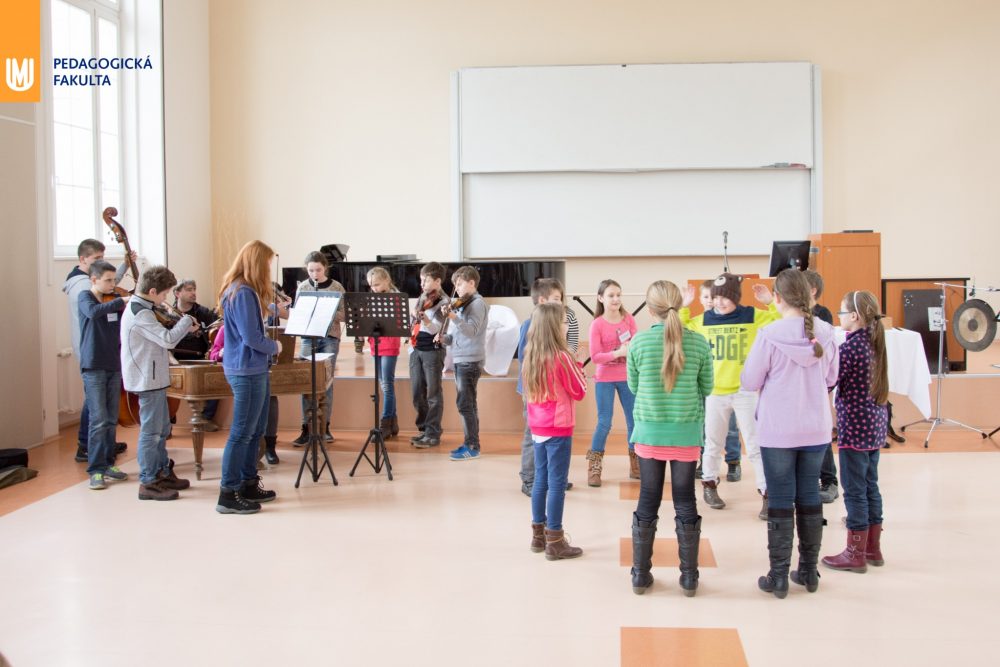The repertoire of the spontaneous folk singing found in Czech, Moravian and Silesian collection fund is created by the songs and compositions of different character and provenience. There are two different areas of tunes which differ melodically, rhythmically, harmonically and formally (Hostinský 1906; Smetana – Václavek 1935, 1950). Between both melody types, it is possible to draw a boundary line through the area of east Moravia (Holý 1967). Observing this dividing line, we assign the music folklore of Bohemia and west Moravia to so-called western melody type. The eastern type includes mainly the song fund of east Moravia. Both song types do not appear separately, they often overlap, in some ethnographic regions they live next to each other (Holý 1967).
Dance songs represent a very large group from the functional point of view. In school education we may rely on ethno-musicological and ethnochoreological knowledge (Toncrová 2000, Matuszková 2000), e. g. the definition of basic characteristic features of dance melodies:
- the area of Bohemia and west Moravia
- the songs to dances with fixed relations to music accompaniment (formerly so-called figural dances), e. g. one melody corresponds to one dance. Here belong the melodies to two-beat and three-beat dances, e. g. hulán, dupák, šotyška, kalamajka, mazurka etc.;
- interesting are the dances in alternating time, so-called mateníky in which the time and dance step change (in a lesser number they appear also in east and north-east Moravia);
- the area of east and south-east Moravia
- especially characteristic are the songs to two-beat dances whose basic movement sign is the gyration of a dancing couple around the common axis (so-called rotating dances). In individual regions, these are various modifications of one dance scheme to which different songs are sung. There are e. g. vrtěná, danaj, sedlcký(á), sedlácká, skočná, starosvětská, koulaná (gúlaná), točená etc.;
- a significant group are the dances of more serious, almost ceremonial character in a three-beat time, e. g. coufavá, zavádka, valaská, starodávný;
- a specific dance type in south-east Moravia is the male dance verbuňk. It has an improvisational character, its accompanying melody has a dotted rhythm; the slow part of the dance is in 4/4 time, quick in 2/4 time.
References
- Holý, D. (1967). Na okraj etnografické hranice na Moravě [Marginal Notes on the Ethnographic Border in Moravia]. Národopisný věstník československý II (XXXV), pp. 21-41. Praha: Národopisná společnost československá.
- Hostinský, O. (1906). Česká světská píseň lidová. Úvahy národopisné a hudební [Czech Secular Folk Song. Ethnographic and Music Reflections] Praha: F. Šimáček.
- Matuszková, J. (2000). Typologie lidového tance [Typology of Folk Dance]. In J. Jančář et al. (eds.). Lidová kultura na Moravě [Folk Culture in Moravia]. Vlastivěda moravská. Země a lid. Nová řada, vol. 10. Strážnice: Ústav lidové kultury ve Strážnici; Brno: Muzejní a vlastivědná společnost v Brně, pp. 306–313.
- Smetana, R. & Václavek, B. (1935). Lidová píseň [Folk Song]. In Ottův slovník naučný nové doby. Dodatky III, vol. 2, pp. 1192-1195. Praha: Nakladatelství J. Otto spol. s r.o.
- Smetana, R. & Václavek, B. (1950). O české písni lidové a zlidovělé [On Czech Folk Song]. Praha: Svoboda, pp. 133-141.
- Toncrová, M. (2000). Bádání o hudebním folkloru. Písňové druhy a zpěvní příležitosti. Skladba repertoáru [Research in Music Folklore. Song Types and Singing Opportunities. The Structure of Repertoire]. In J. Jančář et al. (eds.). Lidová kultura na Moravě [Folk Culture in Moravia]. Vlastivěda moravská. Země a lid. Nová řada, vol. 10. Strážnice: Ústav lidové kultury ve Strážnici; Brno: Muzejní a vlastivědná společnost v Brně, pp. 275–286.
Module Overview
|
